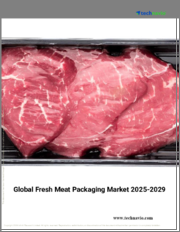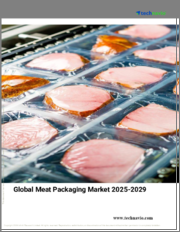
|
시장보고서
상품코드
1621834
가금류 포장 시장 기회, 성장 촉진요인, 산업 동향 분석 및 예측(2024-2032년)Poultry Packaging Market Opportunity, Growth Drivers, Industry Trend Analysis, and Forecast 2024 - 2032 |
||||||
세계 가금류 포장 시장은 2023년 4.3억 달러로 평가되었고, 내구성 있고 효율적인 포장을 필요로 하는 적절한 조리된 가금류 식품에 대한 수요가 증가함에 따라 2024-2032년간연평균 5.1% 성장할 것으로 예상됩니다.
또한, 지속 가능한 포장 솔루션에 대한 소비자의 선호도가 높아지면서 시장 확대가 가속화되고 있습니다. 환경에 대한 인식이 높아짐에 따라 생분해성 및 친환경 포장재를 선택하는 소비자가 증가하고 있습니다. 퇴비화 및 재활용이 가능한 옵션과 같은 포장 혁신은 점점 더 보편화되고 있으며, 이는 지속가능성 트렌드와 일치하여 시장 성장을 가속하고 있습니다.
그러나 지속 가능한 포장재의 높은 비용은 업계에서 두드러진 도전이 되고 있습니다. 생분해성 플라스틱 및 재활용 재료와 같은 친환경적인 선택은 수요가 있지만 기존 포장재에 비해 비용이 높기 때문에 특히 소규모 생산자에게는 장벽이 될 수 있습니다. 특히 경쟁이 치열하고 가격에 민감한 시장에서는 지속 가능한 관행을 채택하는 데 따른 경제적 부담으로 인해 친환경 솔루션으로의 전환이 지연될 수 있습니다. 재료별로 보면 종이 및 판지 부문은 2032년까지 30억 달러에 달할 것으로 예상됩니다. 이러한 성장은 이러한 재료가 플라스틱보다 친환경적인 대안으로 간주되고 지속가능성에 대한 관심이 높아진 것이 주요 원인으로 분석됩니다.
종이 기반 포장은 재활용이 가능하고 생분해가 가능하기 때문에 특히 강도와 장벽을 향상시키는 첨단 포장을 통해 가금류와 같은 부패하기 쉬운 품목에 적합한 포장재로 각광받고 있습니다. 최종 용도 측면에서 전자상거래 부문은 2024년부터 2032년까지 연평균 7% 이상의 성장률을 보일 것으로 예상됩니다. 온라인 식료품 쇼핑 증가는 소비자들이 집에서 편리하게 상품을 주문할 수 있는 편리함을 추구하면서 가금류 포장 시장에 변화를 가져오고 있으며, 전자상거래는 간편하고 유연한 쇼핑 경험을 제공하고, 특히 바쁜 개인이나 오프라인 매장에 접근하기 어려운 사람들에게 매력적이어서 이 부문의 성장을 견인할 것으로 보입니다. 2023년 북미가 조리된 가금류 제품에 대한 수요 증가로 인해 시장 점유율 35%를 차지할 것으로 예상되며, 이는 이 부문의 성장을 더욱 촉진하고 있습니다.
| 시장 범위 | |
|---|---|
| 시작 연도 | 2023년 |
| 예측 연도 | 2024년-2032년 |
| 시작 금액 | 430억 달러 |
| 예상 금액 | 65억 달러 |
| CAGR | 5.1% |
식품 안전에 대한 관심 증가와 함께 유통기한과 신선도를 향상시키는 혁신적인 포장 솔루션이 이러한 성장을 뒷받침하고 있습니다. 중국에서는 도시화와 간편식 솔루션으로의 전환이 매출 증가를 촉진하는 가운데, 가공 및 조리된 제품에 대한 수요 증가에 힘입어 가금류 포장 시장이 빠르게 성장하고 있습니다.
목차
제1장 조사 방법과 조사 범위
제2장 주요 요약
제3장 산업 인사이트
- 생태계 분석
- 밸류체인에 영향을 미치는 요인
- 이익률 분석
- 변혁
- 향후 전망
- 제조업체
- 유통업체
- 공급업체 상황
- 이익률 분석
- 주요 뉴스
- 규제 상황
- 영향요인
- 성장 촉진요인
- 가금 가공제품에 대한 수요 증가
- 친환경 포장재료에의 선호도 증가
- 엄격한 식품 안전 규제가 수요를 촉진
- 도시화에 의한 가금 소비량 증가
- 산업 잠재적 리스크와 과제
- 사스테이나불 포장 자재 고비용
- 플라스틱 포장 사용에 대한 환경 문제
- 성장 촉진요인
- 성장 가능성 분석
- Porter's Five Forces 분석
- PESTEL 분석
제4장 경쟁 구도
- 서론
- 기업 점유율 분석
- 경쟁 포지셔닝 매트릭스
- 전략 전망 매트릭스
제5장 시장 추정·예측 : 재료별, 2021-2032년
- 주요 동향
- 플라스틱
- 종이 및 판지
- 기타
제6장 시장 추정·예측 : 포장 유형별, 2021-2032년
- 주요 동향
- 트레이
- 상자·카톤
- 백&파우치
- 필름&랩
- 크램쉘
- 기타
제7장 시장 추정·예측 : 기술별, 2021-2032년
- 주요 동향
- 가스 치환 포장(MAP)
- 활성포장
- 쉬링크 포장
- 진공포장
- 기타
제8장 시장 추정·예측 : 최종 용도별, 2021-2032년
- 주요 동향
- 슈퍼마켓/하이퍼마켓
- 육류 전문점
- 퀵서비스 레스토랑(QSR)
- E-Commerce
- 기타
제9장 시장 추정·예측 : 지역별, 2021-2032년
- 주요 동향
- 북미
- 미국
- 캐나다
- 유럽
- 영국
- 독일
- 프랑스
- 이탈리아
- 스페인
- 러시아
- 아시아태평양
- 중국
- 인도
- 일본
- 한국
- 호주
- 라틴아메리카
- 브라질
- 멕시코
- 중동 및 아프리카
- 남아프리카공화국
- 사우디아라비아
- 아랍에미리트
제10장 기업 개요
- Amcor
- Anchor Packaging
- Berry Global
- CKF
- Faerch Plast
- Klockner Pentaplast
- Mannok Pack
- Multivac Group
- ProAmpac
- Safepack
- Sealed Air
- Sealpac International
- Smart Packaging Solutions
- Smurfit Kappa
- Stora Enso
- Tekni-Plex Consumer Products
- ULMA Group
- Viskoteepak
- WestRock
- Winpak
The Global Poultry Packaging Market was valued at USD 4.3 billion in 2023 and is projected to grow at a CAGR of 5.1% from 2024 to 2032, driven by the growing demand for appropriate, ready-to-cook poultry foods that need durable and efficient packaging. In addition, increasing consumer preferences for sustainable packaging solutions propel market expansion. As environmental awareness grows, more consumers are opting for biodegradable and eco-friendly packaging materials. Innovations in packaging, such as compostable and recyclable options, are becoming more popular, aligning with sustainability trends and boosting the market's growth.
However, the high cost of sustainable packaging materials presents a notable challenge for the industry. While eco-friendly options such as biodegradable plastics and recycled materials are in demand, their higher cost compared to traditional packaging can be a barrier, particularly for smaller producers. The financial strain of adopting sustainable practices, especially in a highly competitive and price-sensitive market, can slow down the transition to greener solutions. On the basis of materials, the paper and paperboard segment is anticipated to reach USD 3 billion by 2032. This growth is largely due to the increased focus on sustainability, as these materials are seen as more eco-friendly alternatives to plastic.
Paper-based packaging, being recyclable and biodegradable, is gaining traction, especially with advancements that improve its strength and barrier properties, making it suitable for perishable items like poultry. In terms of end-use, the e-commerce segment is set to grow at a CAGR of over 7% between 2024 and 2032. The rise of online grocery shopping is transforming the poultry packaging market as consumers seek the convenience of ordering products from the comfort of their homes. E-commerce offers an easy and flexible shopping experience, particularly appealing to busy individuals and those with limited access to physical stores, further fueling the growth of this segment. North America held a 35% market share in 2023, driven by growing demand for ready-to-cook poultry products.
| Market Scope | |
|---|---|
| Start Year | 2023 |
| Forecast Year | 2024-2032 |
| Start Value | $4.3 Billion |
| Forecast Value | $6.5 Billion |
| CAGR | 5.1% |
Innovative packaging solutions that enhance shelf life and freshness, combined with a heightened focus on food safety, support this growth. In China, the poultry packaging market is experiencing rapid expansion, fueled by the increasing demand for processed and ready-to-eat products, as urbanization and a shift toward convenient meal solutions drive higher sales.
Table of Contents
Chapter 1 Methodology & Scope
- 1.1 Market scope & definitions
- 1.2 Base estimates & calculations
- 1.3 Forecast calculations
- 1.4 Data sources
- 1.4.1 Primary
- 1.4.2 Secondary
- 1.4.2.1 Paid sources
- 1.4.2.2 Public sources
Chapter 2 Executive Summary
- 2.1 Industry synopsis, 2021-2032
Chapter 3 Industry Insights
- 3.1 Industry ecosystem analysis
- 3.1.1 Factor affecting the value chain
- 3.1.2 Profit margin analysis
- 3.1.3 Disruptions
- 3.1.4 Future outlook
- 3.1.5 Manufacturers
- 3.1.6 Distributors
- 3.2 Supplier landscape
- 3.3 Profit margin analysis
- 3.4 Key news & initiatives
- 3.5 Regulatory landscape
- 3.6 Impact forces
- 3.6.1 Growth drivers
- 3.6.1.1 Increasing demand for processed poultry products
- 3.6.1.2 Rising preference for eco-friendly packaging materials
- 3.6.1.3 Stringent food safety regulations driving demand
- 3.6.1.4 Urbanization fueling higher poultry consumption
- 3.6.2 Industry pitfalls & challenges
- 3.6.2.1 High costs of sustainable packaging materials
- 3.6.2.2 Environmental concerns over plastic packaging use
- 3.6.1 Growth drivers
- 3.7 Growth potential analysis
- 3.8 Porter's analysis
- 3.9 PESTEL analysis
Chapter 4 Competitive Landscape, 2023
- 4.1 Introduction
- 4.2 Company market share analysis
- 4.3 Competitive positioning matrix
- 4.4 Strategic outlook matrix
Chapter 5 Market Estimates & Forecast, By Material, 2021-2032 (USD Million)
- 5.1 Key trends
- 5.2 Plastic
- 5.3 Paper & paperboard
- 5.4 Others
Chapter 6 Market Estimates & Forecast, By Packaging Type, 2021-2032 (USD Million)
- 6.1 Key trends
- 6.2 Trays
- 6.3 Boxes & cartons
- 6.4 Bags & pouches
- 6.5 Films & wraps
- 6.6 Clamshells
- 6.7 Others
Chapter 7 Market Estimates & Forecast, By Technology, 2021-2032 (USD Million)
- 7.1 Key trends
- 7.2 Modified atmosphere packaging (MAP)
- 7.3 Active packaging
- 7.4 Shrink packaging
- 7.5 Vacuum packaging
- 7.6 Others
Chapter 8 Market Estimates & Forecast, By End Use, 2021-2032 (USD Million)
- 8.1 Key trends
- 8.2 Supermarkets/Hypermarkets
- 8.3 Specialty meat shops
- 8.4 Quick service restaurants (QSR)
- 8.5 E-Commerce
- 8.6 Others
Chapter 9 Market Estimates & Forecast, By Region, 2021-2032 (USD Million)
- 9.1 Key trends
- 9.2 North America
- 9.2.1 U.S.
- 9.2.2 Canada
- 9.3 Europe
- 9.3.1 UK
- 9.3.2 Germany
- 9.3.3 France
- 9.3.4 Italy
- 9.3.5 Spain
- 9.3.6 Russia
- 9.4 Asia Pacific
- 9.4.1 China
- 9.4.2 India
- 9.4.3 Japan
- 9.4.4 South Korea
- 9.4.5 Australia
- 9.5 Latin America
- 9.5.1 Brazil
- 9.5.2 Mexico
- 9.6 MEA
- 9.6.1 South Africa
- 9.6.2 Saudi Arabia
- 9.6.3 UAE
Chapter 10 Company Profiles
- 10.1 Amcor
- 10.2 Anchor Packaging
- 10.3 Berry Global
- 10.4 CKF
- 10.5 Faerch Plast
- 10.6 Klockner Pentaplast
- 10.7 Mannok Pack
- 10.8 Multivac Group
- 10.9 ProAmpac
- 10.10 Safepack
- 10.11 Sealed Air
- 10.12 Sealpac International
- 10.13 Smart Packaging Solutions
- 10.14 Smurfit Kappa
- 10.15 Stora Enso
- 10.16 Tekni-Plex Consumer Products
- 10.17 ULMA Group
- 10.18 Viskoteepak
- 10.19 WestRock
- 10.20 Winpak



















